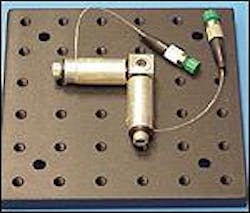
Single-mode, rare-earth-doped fiber lasers and amplifiers are widely used in optical telecommunications and other applications requiring compact, rugged, efficient light sources with diffraction-limited beam quality. Use of these sources for pulsed applications has been hindered, however, by the low pulse energies available compared to bulk solid-state lasers.
"People have gone a long way toward scaling up the continuous-wave power of fiber sources but those sources are still limited for pulsed applications, in terms of how much peak power you can get out," according to Dahv Kliner at Sandia National Laboratories (Livermore, CA). "And a lot of applications such as nonlinear frequency conversion, materials processing and lidar (light detection and ranging) require high-energy pulses."
Normally, pulse energy in fiber is limited by low energy storage as a result of amplified spontaneous emission and by the onset of nonlinear processes in the fiber. The simplest method to overcome both limitations is to increase the core size of the fiber, but this approach is restricted by the need to maintain single-transverse-mode operation. In practice, the upper limit for the core diameter of a single-mode fiber is about 10 μm for wavelengths near 1 μm.
Other methods for getting a multimode fiber to run single mode include controlling launch conditions or laser cavity configuration to preferentially excite the lowest-order mode; as well as controlling the dopant profile to preferentially amplify the lowest-order mode. "These methods aren't all necessarily competitive," Kliner said. "You can do several things at once. You can control the launch conditions as well as control the refractive-index profile to obtain even greater suppression of high-order modes."
Bend-loss approach
Several research groups are focusing on a range of approaches to the problem. Kliner, along with colleagues at the Naval Research Laboratory (Washington, DC), is investigating bend loss as a form of distributed spatial filtering. By strategically choosing the radius of curvature to discriminate against the higher-order modes, attainable pulse energy can be increased by at least a factor of 10 over that available from a single-mode fiber while maintaining diffraction-limited operation, Kliner said.
The research team constructed a ytterbium-doped fiber amplifier with a 25-μm core diameter and seeded it with optical pulses of 0.8 ns duration to obtain output pulses with an energy of 255 μJ, peak power of 305 kW, and average power of 2.2 W, which he says are the highest single-mode pulse energy, peak power, and average power simultaneously extracted from a fiber amplifier (see Fig. 1).
Their method is quite different from a post-filtering operation, however, in which the output of a multimode fiber is focused down and passed through a spatial filter, Kliner cautioned. "Then you would just be throwing out all of the energy," he said. "So you wouldn't really accomplish anything, and you'd also get big intensity fluctuations. Coiling the fiber prevents those higher-order modes from running away with the gain in the first place, so the gain and the energy are still in the fiber to be extracted in the lowest-order mode."Moreover, the coiled fiber system provided smooth, transform-limited temporal and spectral profiles, which are critical for applications such as laser spectroscopy and remote sensing (see Fig. 2). "The technique is simple and inexpensive to implement, does not require complex fiber designs or careful control of the seeding conditions, and is applicable to a wide variety of fiber types," he said. "In addition, the current results do not represent the limit of this technique. And the approach can be used in conjunction with other methods for suppressing high-order modes to obtain even higher pulse energies and peak powers."
REFERENCE
1. F. D. Teodoro, J. P. Koplow, S. W. Moore and D. A. V. Kliner, Opt. Let. 27(7) 518 (April 1, 2002).
Hassaun A. Jones-Bey | Senior Editor and Freelance Writer
Hassaun A. Jones-Bey was a senior editor and then freelance writer for Laser Focus World.
